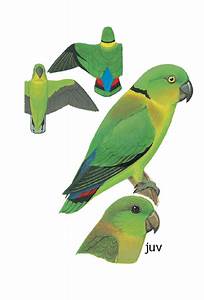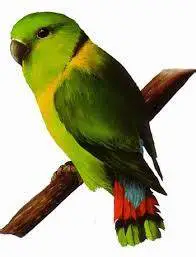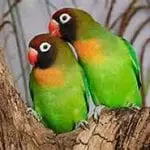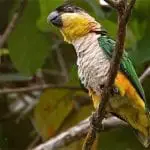Scientific Facts
| Common Name | Black-collared Lovebirds or Swindern’s Lovebirds |
| Scientific Name | Agapornis swindernianus |
| Size | 13cm (5 in) |
| Life Span | 10 to 15 years |
| Habitat | lowland evergreen rainforest, both primary and secondary forest, and occasionally in cultivated areas. |
| Country of Origin | Africa |
Likewise recognized as acollarado, the Black-collared lovebird is one of the most attractive of the nine subspecies in the realm of this breed. Without uncertainty, a bird that all humans would prefer to own in their place.
There are three subspecies of the Black-collared lovebird:
- Cameroon Black-collared lovebird, A. s. zenkeri – Cameroon, Gabon, and Congo
- The nominate subspecies, A. s. swindernianus – Liberia, Côte d’Ivoire, and Ghana
- Ituri Black-collared lovebird or Emin’s lovebird, A. s. emini – the Democratic Republic of the Congo and Uganda.
In 1820, Heinrich Kuh discovered the Black-collared lovebird. The title honors the Dutch professor, Theodore van Swinderen of the University of Groningen.
Physical Description
These little lovebirds generally cover 5 inches in length (13 – 13.5 cm) long (including tailpiece) and measure between 1.8 – 1.5 oz 3 (9 – 41 grams). They are one of the tiniest lovebirds in the realm, and they are identified by a chunky figure, a small round tail, and a moderately huge bill for their entire measurement.

The feathers are chiefly green, somewhat lighter on the upper back and body, and head. Its most notable branding is the unique black half chocker at the rear of the neck (nape). The thorax is olive-yellow or orange, blending toward yellow on the stomach. The bottom has clear red and blue brandings. They have blue upper tailpiece plumage, and the root of the tail is red.
The beak, legs, and feet are gray to black, and the irises are yellow.
It is tricky to identify the sexes of these lovebirds.
The juvenile, they are similar to a grown-up, although without the nuchal neckband. The red tail, blue rump, and green head shades are darker than grown-ups. Irises are brown. Beak light gray with a black blemish at the bottom.

Geographical Range

The Black-collared Lovebirds are local in the West Africa station in at least two (probably three or four) distinct communities. In West Africa, the species is located in the South of Ghana, which latterly transpired in the Bia National Park and Liberia, Ivory Coast (Tai National Park).
In West Central Africa, its population stretches from extreme southwestern Central African Republic, east to the north Congo River, and southern Cameroon south on Gabon.
You can likewise observe from the basin the Congo River in West Uganda.
Habitat
The Black-collared Lovebird resides valley sultry evergreen woodlands, both main and trivial, frequently under the 700 meters; however, several statements show discovery at 1,800 meters in Uganda.
Tours periodically farmed the area. Overall, in small flights (approximately 20 lovebirds), sometimes in bigger crowds throughout the dry season.
It is a bird, commonly, arboreal; common the treetops, where they can be extremely challenging to recognize when they stay quiet.
Forman collective birdhouses in their chosen areas
Common Behavior
Lovebirds (in overall) are not identified for their speaking skill, although some lovebirds do detect terms – the hens are generally always the ones that make this. As is the situation when several tinier parrots, the “sound” of lovebirds is high-volumed and husky, and it may be tricky to follow their expression.
Lovebirds are highly modulated birds, creating harsh, high-pitched sounds that can be an annoyance. They produce sound throughout the day, but particularly at specific terms of the day. They are likewise remarkably energetic and fancy to grind anything. It is smart to watch the birds when permitting outside of their enclosure and to guard any movables or anything they have access to.
Lovebirds are famous for striving to construct dens, particularly during the breeding period – for this cause, baggy stuff such as stripped paper and cloth do not deliver an adequate plaything at specific events of the cycle, as the lovebirds could view it as cradle-making element and venture to match. Reproducing is not something that must be ventured by someone without loads of practice. “Cabins” or concealing spots and little cages are likewise not suitable for the identical purpose.
Lovebirds are likewise identified to be bossy and nippy. Although this can be viewed as entertaining and appealing by several masters, some do not approve it; a lovebird, at the same time a friendly pet, is not for everybody. They snap incredibly hard and adore experimenting with their boundaries – if the master does not fix them ahead on, he or she will own a bird that snaps to make their access.
Diet & Feeding Habits
In the wilderness, lovebirds feast on leaf buds, grains, fruits, berries, seeds, and crops of figs, maize, and corns. A lovebird’s nutrition will comprise of 45-60 grams (1 1/2 to 2 ounces) of feed every day for a single lovebird. Nutrition comprising of a tiny parakeet blend along with a mixture of appendices and vitamins is commonly considered as proper; likewise, a compiled menu along with vegetables, fruits, and greens supplements but without added vitamins is perceived as fit and is a more modern course.
How to Breed
Lovebirds can begin reproducing when they are as youthful as ten months of the term and may proceed until they are five to six ages. They are extremely productive and may provide numerous embryo clutches inside a single year. Because of this, they are frequently promptly obtainable in the pet shop.
Dating occurs when the male serves the female; then, the coupling will appear, which may occur long and recurred a few times a day for numerous days. The male escalates over the female’s rear, frequently holding on to her soaring wings for a great grab. Embryos can be produced as briefly as 3 to 10 days after coupling, then one or more every additional day. Commonly, the clutch consists of 4 to 6 eggs.
The cultivation period is roughly 22 – 25 days, and it can take up to 24 hours for a hatchling to pull itself away from the egg. It’s most meticulous not to obstruct the procedure, except when you noticed that the youngest hatchlings incline to become deserted by the parents.
The behavior between partners will change throughout the breeding season: the female begins preparing the nest, while the male displays more aggressive behavior. There are particular dwelling crates for lovebird-size birds, but if not possible, a cockatiel dwelling crates will execute quite subtle.
Some breeders were extremely prosperous at domesticating newborns by bringing them out of the crates regularly and mingling them and then placing them back with their origins after they were touched for 30 minutes or vaguely. This method, they didn’t demand to hand-feed them — yet the offsprings grew obedient.
Lovebird newborns detach at about 8 weeks of age, with a few earlier and some later. They must be removed toward a healthy assortment of foods, containing seeds, pellets, herbs, and leafy greens, and fresh veggies/fruits.
Pet Care
Lovebirds enjoy to train and need the largest enclosure, like most birds, that your resources and place can provide. Lovebirds are confined in a small enclosure, and never provided any liberty, induce to become disoriented and can exhibit self-harming attitudes. Playthings are a necessity for these lively lovebirds. Have in thought that lovebirds are powerful grinders, so select playthings that can stand up to grinding without creating a risk. With decent attention and a healthy intake, a lovebird can exist between 12 and 15 or more years.
Merely as it is for most birds, a healthy diet is entirely concerning stability for lovebirds. Steady nutrition gives the necessary sources of nutrients: vitamins, minerals, lipids, fiber and carbohydrates, protein, and water. A grain-only intake is a prescription for hunger, and hunger creates several nutrition-related diseases.
The most reliable lovebird serving alternative is concocted nutrition that incorporates the necessary nutrients and doesn’t provide a bird the option to select through and consume solely the pieces he desires. Variety is likewise essential for birds, so supplement concocted nutrition with bird-safe fruit, vegetables, and even sound table meals (without any seasoning or sauces). Determine which foods to refrain, and constantly inquire your doctor before administering food to your lovebird if you have some matters.
Problems
Symptoms of disease to be conscious of are, if a bird seems withdrawn, the following: stays at its feed dish, loses interest in its environment, sleeps a lot, a runny nose, eyes are watery or dull, sits with its eyes closed for long periods, feathers are dull and ruffled. The excrements may alter the shade and be relaxed (if fit, they are not too thin and are grayish-white). Moreover, excessive scratching, sneezing, odd breathing, dropping off its perch, and a lot of tail bobbing.
Some of the prevalent ailments your lovebirds could catch are diarrhea, respiratory ailments, occidiosis, intestinal influenza, egg binding, ticks, mites, internal parasites, bacterial infections, Avian Pox Virus Infection, yeast infections (Candidiasis), Polyoma Virus Infection, Psittacine Beak and Feather Disease, and injuries from fighting. A sick bird must be brought to an avian doctor for treatment and diagnosis promptly!
Availability
Black-collared lovebirds are not promptly obtainable in aviculture, and few are identified regarding their pet capability. Should confined lovebirds be possible, every application must be prepared to set them into a sound breeding plan to preserve this species for later ages.
Without specific local (raw) fig grain, fig pulp, and rice as core nutrition, these lovebirds perished within days influencing several to assume that this species cannot be conformed to remain in confinement. Although there are a few unproven statements of favorably keeping some as pets and even reproducing various color modifications – none have been verified.
Could you keep this bird in captivity?
Numerous lovebirds are admittedly held in confinement without any difficulty, and these can produce a reasonably long history. However, the disappointment of enthusiasts of this bird with the Black-collared lovebird is utterly hopeless.
The breeders who have attempted it have never succeeded in having this bird existing in confinement for longer than half a year and without any symptoms of generation. Moreover, it cannot be shipped from Africa as its diet is largely based on figs from Africa, which are considerably costly and somewhat complicated to obtain as they are 30 meters beneath the soil. This gives her an undesirable bird to have in an enclosure.
Furthermore, it is a bird that does not adjust completely to living in confinement, even if this is achieved when they are youthful. They do not cherish to be bolted up, and the specific type of their diet causes it impracticable to foster them in an aviary. This causes obtaining them totally inaccessible, and as less and less of these lovebirds are viewed in the native, their trading has started to be forbidden in several nations for alarm that the strain may pass.
Conservation
This lovebird has a remarkably broad scope and therefore does not address the entrances for Vulnerable below the array measurement standard (Extent of Occurrence <20,000 km2 coupled with a declining or varying field area, territory quality/extent or population size and a small fraction of positions or harsh fragmentation). The flock inclination seems to be constant, and consequently, the species does not propose the entrances for Vulnerable following the population leaning standard (>30% slump over ten years or three periods).
The flock extent has not been declared, but it is not assumed to resemble the entrances for Vulnerable following the population measurement standard (<10,000 adult exemplars with a progressive deterioration measured to be >10% in ten years or three periods, or with a detailed population formation). For these analyses, the species is assessed as Least Concern.
The population is speculated to be resolute in the lack of proof for any drops or valuable perils.
FAQs
Why do love birds die?
It is assumed that once love birds are matched. They are paired for history. Generally, if one companion perishes, the other dies too because of heartbreak
Do lovebirds need to be in pairs?
Lovebirds do not demand to exist in couples. They are friendly birds accustomed to being in large flocks. As long as a single lovebird receives loads of care from its human partners, there is no requirement for a spouse.
Can lovebird live alone?
While it has been a standard method to have these birds in couples, in some instances, it is more satisfying to retain a lovebird solitary.
Do male love birds build nests?
Both males and females produce long shreds of whatever stuff is accessible, bringing them in the cradle crate. While the female inserts them in her appendages and tail, the male attempts to behave so though prevails disappointed
Is it OK to have one lovebird?
Although lovebirds do not require another lovebird to bestow its enclosure with, it still demands a human to partake its bright life with or else it will shrivel up and perish. If you purchase two birds, they will link with each other and seem so adorable cuddled up to each other though since they have each other, they might not relate to you.
Do male love birds sit on eggs?
Usually, the hen rests and is served by the male. Male lovebirds, however, frequently remain adjacent to the hen, but it is not explicit if they are making anything valuable in times of incubation!
How long does it take to tame a lovebird?
Keep your hand near his enclosure for 10 to 15 minutes (or as long as you can maintain your hand up), two to three times a day, for four to seven days.



